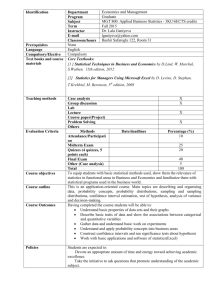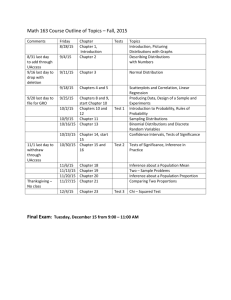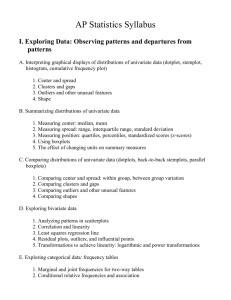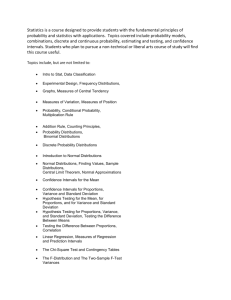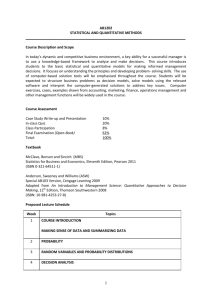Advanced Placement Statistics Syllabus
advertisement
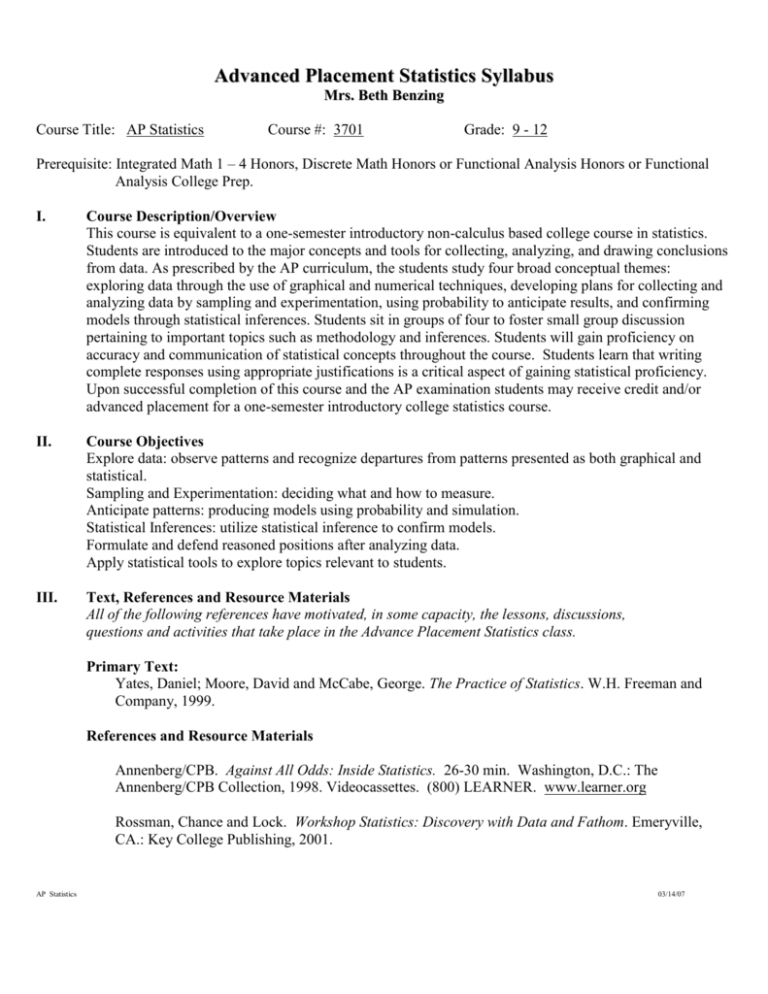
Advanced Placement Statistics Syllabus Mrs. Beth Benzing Course Title: AP Statistics Course #: 3701 Grade: 9 - 12 Prerequisite: Integrated Math 1 – 4 Honors, Discrete Math Honors or Functional Analysis Honors or Functional Analysis College Prep. I. Course Description/Overview This course is equivalent to a one-semester introductory non-calculus based college course in statistics. Students are introduced to the major concepts and tools for collecting, analyzing, and drawing conclusions from data. As prescribed by the AP curriculum, the students study four broad conceptual themes: exploring data through the use of graphical and numerical techniques, developing plans for collecting and analyzing data by sampling and experimentation, using probability to anticipate results, and confirming models through statistical inferences. Students sit in groups of four to foster small group discussion pertaining to important topics such as methodology and inferences. Students will gain proficiency on accuracy and communication of statistical concepts throughout the course. Students learn that writing complete responses using appropriate justifications is a critical aspect of gaining statistical proficiency. Upon successful completion of this course and the AP examination students may receive credit and/or advanced placement for a one-semester introductory college statistics course. II. Course Objectives Explore data: observe patterns and recognize departures from patterns presented as both graphical and statistical. Sampling and Experimentation: deciding what and how to measure. Anticipate patterns: producing models using probability and simulation. Statistical Inferences: utilize statistical inference to confirm models. Formulate and defend reasoned positions after analyzing data. Apply statistical tools to explore topics relevant to students. III. Text, References and Resource Materials All of the following references have motivated, in some capacity, the lessons, discussions, questions and activities that take place in the Advance Placement Statistics class. Primary Text: Yates, Daniel; Moore, David and McCabe, George. The Practice of Statistics. W.H. Freeman and Company, 1999. References and Resource Materials Annenberg/CPB. Against All Odds: Inside Statistics. 26-30 min. Washington, D.C.: The Annenberg/CPB Collection, 1998. Videocassettes. (800) LEARNER. www.learner.org Rossman, Chance and Lock. Workshop Statistics: Discovery with Data and Fathom. Emeryville, CA.: Key College Publishing, 2001. AP Statistics 03/14/07 Peck, Olsen, and Devor. Introduction to Statistics and Data Analysis. Pacific Grove, Calf.: Duxbury, 2001. Scheaffer, Gnanadesikan, Watkins, and Witmer. Activity-Based Statistics: Instructor Resources. New York:Springer-Verlag, 1996. Texas Instrument TI-83 Plus graphing calculator. Fathom 2, Dynamic DataTM Software. Key Curriculum Pres. 2005. Erickson, Tim. Fifty Fathoms Statistics Demonstrations for Deeper Understanding. Oakland, Calf. eeps media. 2002 Other resource materials used in the classroom come from articles in newspapers, journals, and the World Wide Web. Students often bring in data sets they collect or download from the World Wide Web. IV. Course Content (Units, Concepts, Questions, Themes, Tasks Title and Activities based on a one semester 80 minute block schedule) A. Examining Univariate Distributions (week 1 – 2) Key Concepts/Skills Display and describe distributions with graphs (dot plots, stem plots, histograms, and box plots) Describe distributions with numbers (mean, median, quartiles, and standard deviation) Describe distributions by center, shape, spread, gaps, clusters and outliers Compare distributions of data (back-to-back stem plots, parallel dot plots) Compare and contrast normal and skewed distributions Use and apply properties of the normal distribution Use the normal distribution tables Activity US Census data: Compare the distributions of data from the 2000 US census using Fathom and write a summary comparing the distributions. Students explore data statistically and graphically. B. AP Statistics Examining Relationships in Bivariate Data (week 3 – 4) Key Concepts/Skills Display relationships with scatter plots Identify possible linear patterns through correlation Predict relationships with the least square regression line Describe variations in relationships (residual plots, outliers, influential points) Transform data to achieve linearity Predict relationships that are non-linear Explore relations in categorical data (marginal, joint and conditional relative frequencies for two-way tables) 03/14/07 Activity Paper towel lab: Extrapolate the number of paper towels on a roll if given the width of the paper towels by calculating a formula through transforming the data. Gather the sample by collecting the width of different size paper towel rolls and counting the number of paper towels on the roll. Computer lab Outlier and influential points: Conduct demo, Least Squares Regression, from Fifty Fathoms to understand the least squares regression line and outliers and influential points. C. Producing Data (week 5 - 6) Key Concepts/Skills Explore observational study techniques (census, survey, random sampling) Understanding different methods of data collection by sampling Planning and conducting surveys Designing and conducting experiments Explore experimental techniques (blocking, control groups, double blind studies) Read about experimental design Differentiate between association and causation Planning and conducting experiments Activities Denture cleaner lab: Design and conduct an experiment to test which of the two given denture cleaners dissolve faster in soda or in water. The write-up should: describe how randomization was used, indicate what was done to control the experiment for lurking variables, identify the factors and response variables of the experiment and clearly state whether an interaction occurred. Candy experiment: Design an experiment that will test whether candy will dissolve faster in soda or in water. There are two different types of candy in one container that can be used. The purpose of this experiment is for students to understand blocking to control the experiment. D. AP Statistics Sampling Distributions, Probability and Anticipating Patterns (week 7 – 9) Key Concepts/Skills Differentiate between independent and dependent events Explore simple and compound probabilities Understand the concept of sampling distributions Explore probability distributions Utilize the binomial distribution to explore two outcome events Conduct simulations of probability distributions including binomial and geometric Calculate the mean and standard deviation of random variables including binomials Calculate the mean and standard deviation of combining independent random variables Explore sampling distributions of sample proportions and sample means Understanding the Central Limit Theorem Explore sampling distributions of the differences between two independent sample proportions and means. 03/14/07 Project Probability card game: Answer an in-depth probability question by conduction a simulation, playing the game in reality several times and providing a theoretical solution. Write-up must include solutions and describing the process and method for each approach. Activities Random numbers and probability: Write a statement whether you are convinced that a “hot hand” in basketball does not exist. Combining Random Variables: Create a distribution of the sum of two dice by rolling and finding the sum several times. Repeat process by creating a distribution of the difference of two dice. Find the theoretical means and standard deviations of the distributions and compare the two data sets. Dice activity: Students roll five dice at a time and describe a distribution that shows the number of fours rolled. A sampling distribution is created from finding the proportion of fours rolled after rolling five dice. Repeat this activity by rolling 50 dice. Students discover the Central Limit Theorem with sample proportions. Doubles: Roll two dice until one rolls doubles. Create a distribution from the data collected in class. Students then create a sampling distribution by finding means of rolling doubles four different times. Repeat process by finding the mean of rolling dice until one gets doubles with a sample size of nine. Students will describe and compare the distributions and discover the Central Limit Theorem. Students continue the activity by simulating the dice rolling by using the probability simulator in the graphing calculator. Computer labs CLT using Fathom: Create a sampling distribution of proportions with Fathom by creating two sliders with n and p and observe how n and p effect the distribution. Sampling Distributions with sample mean family incomes: Sample 1000 family incomes from the US census data using Fathom. Create a sampling distribution of sample mean incomes from the collected data with a sample size of 5 and 50. Compare the three distributions center, shape and spread. E. Introduction to Inference (week 10 – 11) Key Concepts/Skills Calculate and interpret confidence intervals in context Calculate and interpret tests of significance in context Understand inference errors (type I and type II) Computer lab Errors in Hypothesis testing: Explore type I, type II error and power by using a Fathom Demo that shows a sampling distribution by simulating sample mean weights of fours rolls of sod from a truck load of many rolls of sod that have a fixed average mean weight. The purpose of this lab is for students to calculate and interpret statistical inference and then interpret and understand AP Statistics 03/14/07 type I and type II error. Students develop a statistical understanding through exploration of analysis of data and simulation. F. Applying Inference to Distributions and Proportions (week 12 – 14) Key Concepts/Skills Calculate and interpret confidence intervals and tests of significance for proportions and the difference between proportions Calculate and interpret confidence intervals and tests of significance for a mean and the difference between means for small or large sample sizes Calculate and interpret confidence intervals and tests of significance for a matched paired experiment Compare two means of two different populations Describe population spread Predict population proportions Compare two proportions of two different populations Communicate verbally and written methods, results, and interpretations when performing a hypothesis test or confidence interval Activities Full write-ups of the following activities must include the design of the experiment, the hypothesis in symbols and words, checking of conditions, the appropriate test conducted and a conclusion in context of the problem. The purpose of these activities have students bring all aspects of the statistical process, including design, analysis, and conclusions. Tissue lab: Collect and test whether students prefer one tissue brand to another. Students collect data and conduct a one sample proportion test. The lab also allows students to check appropriate conditions. Animal Cracker lab: Collect data and test whether Nabisco has an average of 19 animal crackers per box. This lab allows students to discover the t-distribution and compute a one sample t-test and one sample t-interval. Dominate versus non-dominate hand: Design, conduct and test whether ones dominate hand writes faster than ones non-dominate hand. Students conduct a match paired experiment. Coke or Diet Coke lab: Collect data and test whether diet coke weighs more the regular coke. This experiment allows students to discover the difference between a one sample and two sample t-test. G. Applying Inference to Problems with Categorical Variables (week 15 – 16) Key Concepts/Skills Understand the chi-square distribution Construct and analyze two way tables Apply the chi-square test as a test of significance AP Statistics 03/14/07 Activity: M&M’s lab: Conduct an experiment testing if the colors of M&M’s are distributed to the company’s claim. This experiment allows students to conduct a chi-squared test of goodness of fit. H. Inference for Regressions and review (week 17) Key Concepts/Skills Review the linear regression model Construct confidence intervals for the slope of a regression line Apply significance tests to regression lines Activities Helicopter lab: Estimate the speed of paper helicopters. Students work in groups to design and perform the experiment. Students provide a written report that describes the methods of collecting the data, statistical analysis and interpretation of their findings. Group Project Report: Design and conduct a survey of the school and present findings in a written report again describing the method of data collection, the statistical analysis and any interpretations of their finding. Graphical and statistical results should be provided. V. Assessment A variety of assessment tools that are aligned with the Advancement Placement curriculum are used in this course. Daily participation, quizzes and exams make up the core of the assessment. Additional grades are earned by students in other areas such as: Presenting weekly newspaper or journal articles. A written summary of the article including how the article relates to statistics. Homework is given daily. Most homework problems are assigned from the Yates, Moore, McCabe book and are due the next day, but there are also long term assignments given. Submission of “labs” in areas of descriptive statistics, experimental design, probability, and inference. Computer lab write-ups using Fathom by exploring concepts in the curriculum. Practice AP questions from previous AP exams. VI. Grading Policy The final grade for this course is determined by the accumulation of grades from the two marking periods and the final examination. Each of the two marking periods is valued at 40% and the final examination accounts for the remaining 20% of the yearly grade. Marking period grades are based on a point system. Averages are calculated by dividing the total points earned by the student by the total number of possible points. The school scale is used to determine grades: A (90-100%), B (80-89%), C (70-79%), D (60-69%), and F (below 60%). AP Statistics 03/14/07


